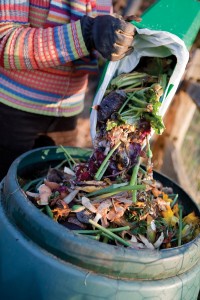
A shocking 40% of food in the United States gets wasted, according to several estimates. Waste is happening at every part of the food chain: thousands of pounds of fresh vegetables are being left in the fields to rot, supermarkets are dumping blemished produce, restaurants must toss perfectly good leftovers, and consumers are letting food molder away in their refrigerators.
In Bon Appétit Management Company cafés, we struggle with leftover dishes that can’t be served again, guests who grab more food than they can stomach, catered events with unpredictable attendance, and of course, all the vegetable and meat odds and ends that can’t be consumed, like bones and onion peelings (from which we do first extract every drop of flavor!).
Yet at the same time, one in every six Americans — or about 50.1 million people, a good portion of whom are children and senior citizens — lacks a secure supply of food. Clearly, we have a problem.
At Bon Appétit, we hate food waste with a passion. It’s a big contributor to climate change. Wasting food means you’re also wasting all the energy it took to grow, harvest, transport, and cook it. In addition, food decomposing in landfills releases methane, the greenhouse gas that is 20 to 25 times more powerful than carbon dioxide. According to the U.S. Environmental Protection Agency, landfills are the largest human-related source of methane in the United States.
Secondly, it pains us to see perfectly good food end up in the compost bin when it could be used to feed people in need. Feeding America estimates that only 5 billion pounds of food would be needed to end hunger in the United States. About 22 billion pounds of edible food is wasted annually in the food service industry alone.
What Bon Appétit is doing
We are proud to have reduced our food waste by 30 percent in 2007, when we first launched our Low Carbon Diet program (which has a major food waste component), and have been able to keep it down since. Currently, we estimate that the teams at our cafés divert approximately 40 percent (by weight) of what remains of their food waste from landfills. We try to stop waste from happening in the first place by:
- Preparing food from scratch. All of our chefs cook from scratch using fresh, local, and seasonal products. We encourage snout-to-tail and stem-to-root cooking by making all of our own stocks and soups — great destinations for bones and vegetable trimmings.
- Batch cooking. Our vegetables are prepared in batches at the last possible minute and served in the smallest possible quantities, to ensure both freshness and that we don’t prepare more food than is needed.
- Talking people out of trays. In 2005 our general manager at Saint Joseph’s College of Maine pioneered trayless dining after he found he could cut consumer waste in half simply by removing the trays from the café. Trayless dining is now a nationwide movement – dozens of our college dining halls and corporate cafés have tossed their trays. Going trayless encourages people to take just what they can eat, not what they can carry, and substantially cuts down on post-cooking food waste.
Even though we are proactive, there is always inevitably some food going to waste. We try to find alternative uses and destinations for it by:
- Composting and recycling. We compost food waste on site and through municipal programs; we send scraps to Farm to Fork partners (for animal feed or composting) and waste fryer oil to bio-fuel processors (in fact, some of our catering vans run on waste vegetable oil from our cafés).
- Food recovery. Around the country, we work with food banks and nonprofit organizations such as the Food Recovery Network, a student-operated nonprofit working on college campuses, and Feeding America, the nation’s largest domestic hunger-relief charity, to take leftover food from our cafés that would otherwise go to waste, and serve it to people in need within our communities.
Learn more